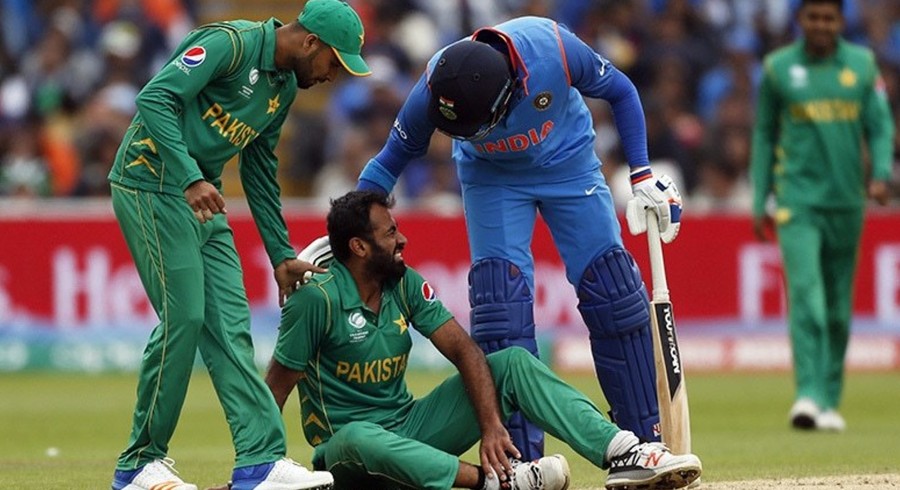For Pakistan to defeat India on Sunday, they need to focus a lot more on the little things
 PHOTO: AFP
PHOTO: AFP
When you hear the term David and Goliath, the mind immediately jumps to strong vs. weak, big vs. small, perfection vs. imperfection. In a real-world scenario, it’s not often that you see a David outdo a Goliath. But what if your understanding of the scenario is flawed? Canadian author Malcolm Gladwell argues that Goliath has weaknesses; meanwhile, David’s underdog status may be magnified, and he may have some hidden secrets. So, on to the supposed David (Pakistan) and Goliath (India) clash on Sunday.
The Pakistan cricket team is not as bad as many analysts would make them out to be. Nor is it as strong as some ardent fans of the Men in Green may think. Pakistan is a middling cricket team that’s on the way up. Under Mickey Arthur’s tutelage and Sarfaraz Ahmed’s leadership, the team has steadily risen up the ODI rankings after dropping to number 9 in 2015. However, since defeating India in the 2017 Champions Trophy final, the progress appears to have stagnated.
Almost two years on from that euphoric day, the two teams are set to clash in the group stage of the 2019 International Cricket Council (ICC) World Cup. India, in the preceding years, have consolidated their already strong team with two high-quality wrist spinners and a method that consistently sees them win games. Pakistan have, meanwhile, stumbled from series to series in the search of a combination which will see them consistently win games. But for some reason, it rarely all clicks together for Sarfaraz Ahmed’s men. On the rare occasions that they get it right, they can defeat the number one ranked side in a World Cup. On another day, they can lose to just about anyone and everyone.
For Pakistan to defeat India on Sunday, they need to focus a lot more on the little things. In the previous World Cup match against Australia, Pakistan had lapses in all three facets of the game. Against a well-oiled machine like India, you can’t afford to bowl poorly in the first 15 overs, as Shaheen Shah Afridi and Hasan Ali did in their initial spells against Australia. Short-pitched bowling on a slightly damp pitch, and wayward lines and lengths are not the recipes for success. Neither are dropped catches, and conceding several runs in the field, courtesy lethargic ground-fielding. Somehow, Pakistan put all these weaknesses together against Australia and then bounced back with 89/8 in the last 16 overs, turning the innings around completely after the Aussies looked set for a total in excess of 350.
As for Pakistan batting, it all started early on with Fakhar Zaman throwing his bat at a wide delivery. The pattern of soft dismissals was to continue, the softest of them being Mohammad Hafeez falling to a lollypop of a full toss by a spinner, caught at the boundary. The increasingly hapless Shoaib Malik and unreliable Asif Ali fell in quick succession and the chase was all but over, despite some lower-order blows.
India, as a cricket team, is very reliant on their top three batsmen, not unlike Pakistan. While the eastern neighbours’ top 3 are far more accomplished than Pakistan’s trio, they will be missing injured talisman Shikhar Dhawan. In his replacement, likely to be KL Rahul, exists Pakistan’s first chance of exploiting India’s vulnerability. The 27-year-old is yet to cement his position in the Indian ODI team; knowing Pakistan, however, he may end up doing just that on Sunday. Mohammad Amir, armed with a strong record against Rohit Sharma, can be confident of his chances of dismissing his nemesis. Virat Kohli, the best batsman in the world, is truly a giant of the game and dismissing him is key to Pakistan’s chances. The only way they can do that is via disciplined bowling and fielding, along with a close-to-perfect game plan. That doesn’t guarantee success, but it certainly gives you the best chance. Once Pakistan can get India’s top 3, they’re in the game.
Pakistan’s batting represents a peculiar mystery. The numbers are very good, but the soft underbelly is undeniable. Shoaib Malik, averaging less than 30 in ODIs since 2018 and less than 15 in England, is a liability in the line-up more often than not. It’s difficult to see why a batsman averaging in excess of 45, i.e. Haris Sohail, should be benched when Pakistan are prone to middle-order seizures. Considering India’s potent opening pacers, the men in green have to conserve early wickets at any cost.
Unfortunately, the Pakistan team lacks (good) experience. Mohammad Hafeez and Shoaib Malik have been around for the best part of two decades, yet will never demand the respect and adulation reserved for the likes of Inzamam-ul-Haq and his ilk. As a result, the Pakistan team is learning through trial and error. Now it is crunch time, it’s the biggest event in cricket, and there is a trophy to be won.
Having said that, there will be another World Cup in four years’ time, and barring a few senior players, much of this team has the chance of returning in 2023, rejuvenated and more experienced. If Pakistan lose against India, it won’t be the end. David may lose the battle, but then Goliath was always the favourite. Pakistan supporters must back the team and hope for the best, but know the limitations of what is quite a young and relatively inexperienced team. The process of being a cricket team and a cricket fan never really comes to a stop, as long as you have the will to stick with the team through its highs and lows. If you don’t, then maybe Pakistan cricket isn’t for you.
The views expressed by the writer and the reader comments do not necessarily reflect the views and policies of Cricket Pakistan.